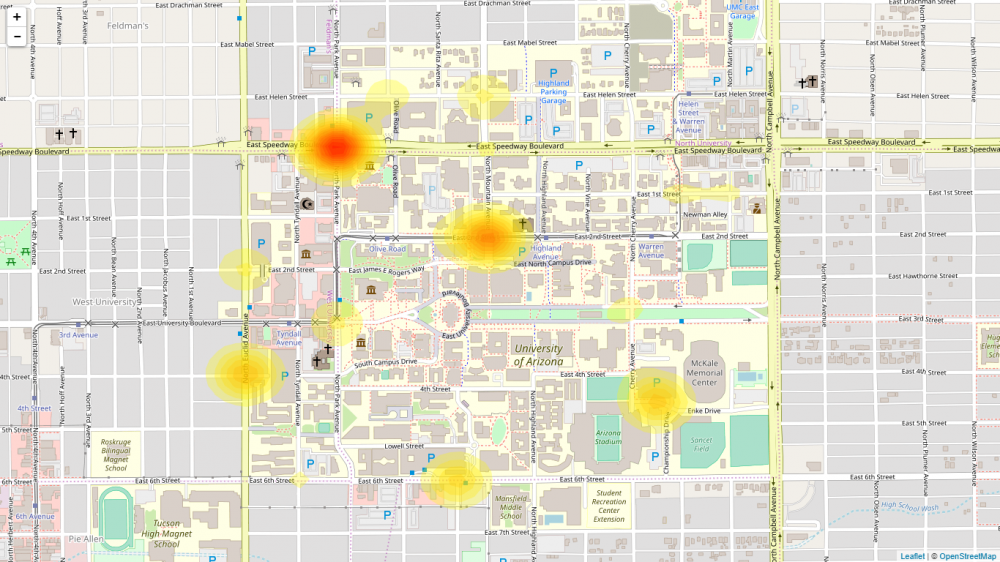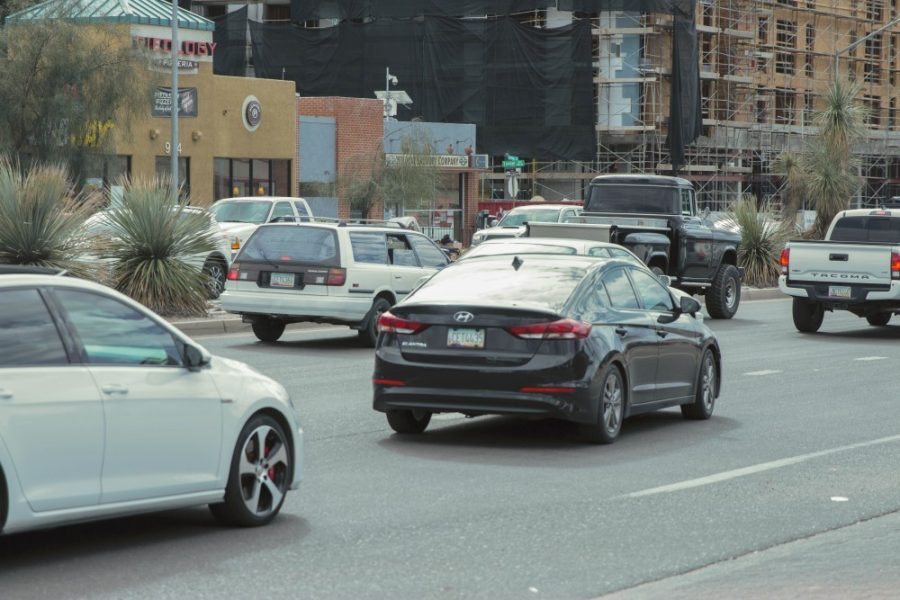Like “The Hunger Games” of daily commutes, at almost any given time the University of Arizona campus is bustling with lines of cars, bicycles and crowds of pedestrians.
This constant flow of traffic on the streets and sidewalks often lead to accidents both on and near campus. From the beginning of last semester to the end of February 2019, the University of Arizona Police Department has responded to over 120 traffic incidents.
Sgt. Cindy Spasoff, UAPD’s Public Information Officer in Crime Prevention, said instances where a pedestrian is hit on the roadways, bicycle accidents, car accidents and hit-and-runs all fall under “traffic incidents.”
According to the UAPD Crime Map, the intersection of East Speedway Boulevard and North Park Avenue alone has had 16 reported incidents this academic year.

That intersection also falls under the jurisdiction of the Tucson Police Department Spasoff said.
TPD responded to 28 traffic incidents over the past six months, making Speedway and Park the most dangerous intersection on campus.
“There’s a lot of pedestrian traffic in that area due to the 7-Eleven, Circle K and food vendors on those corners,” Spasoff said.
Spasoff said the traffic from residential high-rises and the number of bicyclists in that area also increase the likelihood of accidents.
The second most common site for campus traffic incidents is the intersection of East Second Street and North Mountain Avenue, which had 17 reported incidents this academic year. On three of the intersection’s corners lie the Second Street parking garage, the Student Union Memorial Center and the parking lot for the Tucson LDS Institute of Religion.
“That’s a lot of cars coming into such a small area,” Spasoff said. “There’s too much going on there during class changes, especially with the streetcar going through there.”
RELATED: UAPD traffic safety program issues 99 warnings in March
Jenna Rivera, a sophomore majoring in journalism, was involved in an accident near the intersection of East Second Street and North Mountain Avenue in November.
“It was about 1 in the afternoon and as I was circling the round-about by the student union, a pedestrian popped up at the left side of my bumper,” Rivera said. “I slammed the breaks and he tried to stop but because he was on his skateboard, he instead jumped up and flew right into the windshield.”
Rivera said the pedestrian who was hit broke his arm, had to get stitches and suffered a slight concussion.
She did not get injured and did not get a ticket, but left campus that day with a shattered windshield and a dented car door.
“The pedestrian who I had hit ended up getting a citation from the police because he had been on his phone and looked up and that’s when he had noticed me,” Rivera said.
Alyssa Lizardi, a senior majoring in care, health and society, witnessed a similar accident at that same intersection and at the same time of day in early February.
“I saw a guy get hit by a car at the stoplight by the student union,” Lizardi said. “He was riding one of those electric skateboards and got clipped.”
The intersection of North Park Avenue and East Speedway Boulevard and the intersection of East Second Street and North Mountain Avenue have been hotspots for traffic incidents over the past two years. Of the 292 incidents reported since February 2017, 59 were at the Park and Speedway intersection and 40 took place at the Second Street and Mountain intersection.
According to the UAPD crime map statistics, most accidents over the past six months have taken place around 9 a.m. and between 3 and 6 p.m. Over the past two years this trend has remained, with 9 a.m. being the most common time for incidents and also when many UA classes begin.
According to Spasoff, a grant the UAPD received will help the department educate students on bicycle and pedestrian safety and enforce traffic laws, which could reduce the amount of accidents on campus. The grant of over $15,700 from the Arizona Governor’s Office of Highway Safety allows UAPD officers to go to busy intersections and make sure traffic laws are being observed.
RELATED: UAPD receives two grants related to improving public awareness of traffic laws
“We’re basically trying to keep people stopping at stop signs, not hitting pedestrians and being good citizens,” Spasoff said.
The grant also helps the UAPD hold educational tables to provide students with resources and answer questions about bicycle safety.
Spasoff said students themselves can take certain precautions to stay safe while commuting.
“Keep your eyes on the traffic and don’t expect cars to always stop for you,” Spasoff said.
She also advises against using cell phones while walking, biking and driving because the devices can be distracting.
“That’s always been an issue since phones became so popular,” Spasoff said. “We see a lot of students looking at their phones and crossing [the street] when they shouldn’t.”
Rivera said she thinks students are partially responsible for traffic incidents, especially when cell phones are a factor.
“Students either have their headphones in or are looking down texting, or just don’t care and will walk in front [of your car] whether you’re moving or not,” Rivera said. “I think UAPD and other officials should be more on the lookout for bikers and skateboarders making sure they are not using their cellphones while riding.”
Traffic around campus is nearly unavoidable while attending classes at UA, but staying aware of your surroundings and following traffic laws can help prevent dangerous incidents. And if you do find yourself in the “Hunger Games” of daily commutes, may the odds be ever in your favor.
Follow Jesse Tellez on Twitter









